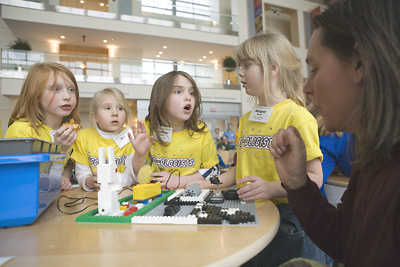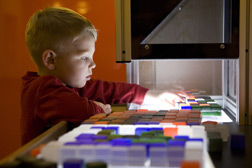Kids at Cornell show off nanotechnology models -- from apples and robots to worms -- one Lego at a time
By Alex Kwan

Children learn from what they see -- and that is why an ant, a dot and a dust particle are among the smallest things in their world. On Jan. 27, though, their smallest got even smaller -- symbolically, at least -- as students from 10 elementary schools in the Finger Lakes region displayed models of microelectronic chips and rotating biological molecules, all made of Legos.
The exhibition, at the Cornell NanoScale Facility in Duffield Hall, was part of the Junior FIRST (For Inspiration and Recognition of Science and Technology) Lego League. The competition pits teams of 6- to 9-year-olds against each other with buckets of Lego pieces and the challenge of building a science-related model at the macro, micro and nano scales.
The Silver Zap Dragons team found their inspiration in a backyard pond. Under a microscope, the children unexpectedly discovered many transparent creatures, called oligochaete worms, which swim between pond water plants. The team spent the next month building Lego models of the pond, worm and the biological motors that propel the tiny organisms to depict the different length scales in our world. "I learned that if you are doing a hard job, you should work together," said Meg, a young girl from a home-schooled team from Rochester, N.Y.

Other mobile models included a space robot made by the Lego Engineers of the Southern Tier, a team of home-schooled boys from Binghamton, N.Y. The foot-tall robot had bright headlights and giant swing arms.
"One arm can refuel and the other arm had drills to do repairs," said Mark Adams, who one day would like to build robots for the International Space Station. To show what the robot is made of, the team also made models of circuit boards and individual microchips.
The Sweet Winners from Pittsford, N.Y., drew inspiration from the orchard, with models ranging from big (an apple tree) to small (an apple slice). Why apples? "Because we had a lot of red Lego pieces," a team member said.
The event was hosted by the Cornell NanoScale Science and Technology Facility, with help from the Nanobiotechnology Center and the Ithaca Sciencenter.
Graduate student Alex Kwan is a writer intern with the Cornell Chronicle.
Get Cornell news delivered right to your inbox.
Subscribe